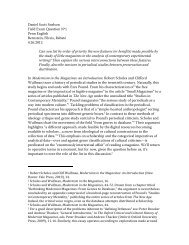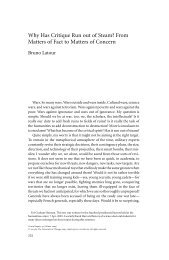The Exploit: A Theory of Networks - asounder
The Exploit: A Theory of Networks - asounder
The Exploit: A Theory of Networks - asounder
You also want an ePaper? Increase the reach of your titles
YUMPU automatically turns print PDFs into web optimized ePapers that Google loves.
Nodes 83<br />
ever, the language <strong>of</strong> biology quickly became a provocative tool for<br />
describing these encapsulations <strong>of</strong> code. Science fiction classics such<br />
as John Brunner’s <strong>The</strong> Shockwave Rider popularized the vitalism <strong>of</strong><br />
computer viruses, and by the early 1980s, researchers such as Fred<br />
Cohen published articles on “computer viruses” in academic journals<br />
such as Computers and Security. 62<br />
In terms <strong>of</strong> understanding networks, one <strong>of</strong> the greatest lessons <strong>of</strong> computer<br />
viruses and their cousins (Internet worms, Trojan horses) is that, like<br />
biological viruses, they exploit the normal functioning <strong>of</strong> their host systems<br />
to produce more copies <strong>of</strong> themselves. Viruses are life exploiting life.<br />
Standard computer viruses essentially do three things: they “infect”<br />
documents or a program by overwriting, replacing, or editing code;<br />
they use the host system to create copies and to distribute copies<br />
<strong>of</strong> themselves; and they may have one or more tactics for evading<br />
detection by users or antivirus programs.<br />
Contrary to popular opinion, not all computer viruses are destructive<br />
(the same can be said in biology, as well). Certainly computer<br />
viruses can delete data, but they can also be performative (e.g., demonstrating<br />
a security violation), exploratory (e.g., gaining access), or<br />
based on disturbance rather than destruction (e.g., rerouting network<br />
traffic, clogging network bandwidth). Originally computer viruses<br />
operated in one computer system at a time and required external media<br />
such as a floppy disk to pass from computer to computer. <strong>The</strong><br />
increasing popularity <strong>of</strong> the civilian Internet, and later the Web,<br />
made possible network - based, self - replicating computer viruses (or<br />
“worms”). For instance, in January 2003, the “Sobig.F” virus, which<br />
used e - mail address books, generated an estimated one hundred million<br />
“fake” e - mails (which amounted to one in seventeen e - mails<br />
being infected in a given day). That same year, the “Blaster” virus<br />
rapidly spread through the Internet, infecting some four hundred<br />
thousand operating systems—all running Micros<strong>of</strong>t Windows. An<br />
attempt was made to release an automated anti - Blaster “vaccine”<br />
called “Naachi”; but the attempt failed, as the purported fix clogged<br />
networks with downloads <strong>of</strong> the Blaster patch from the Micros<strong>of</strong>t<br />
Web site (temporarily disabling a portion <strong>of</strong> the Air Canada and the









